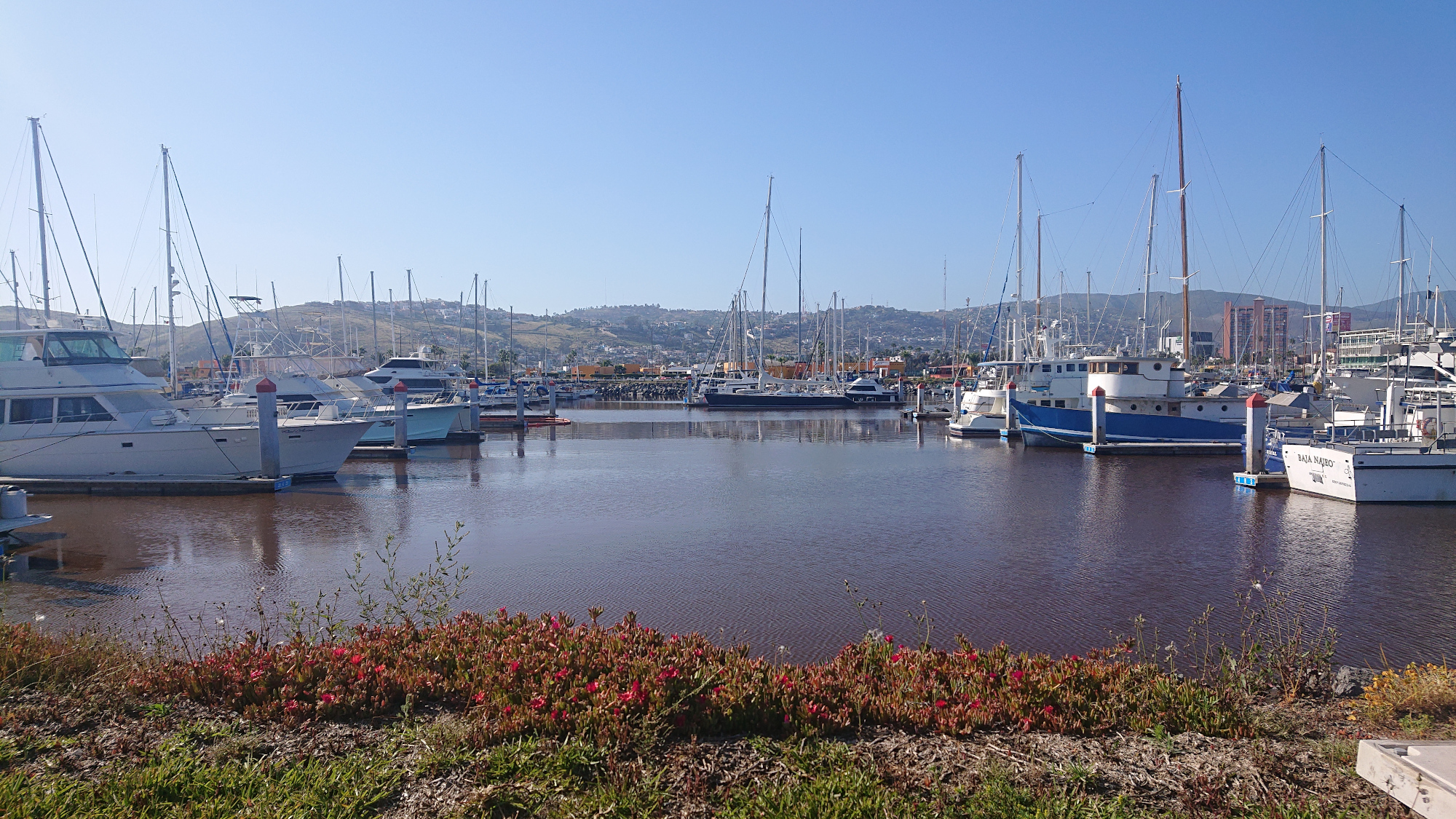We have now been in Ensenada for 2 months. The marina and its environment are very well mapped in our brain circuits. Most of our time spent here the town has been operating on essential services only and with at home isolation, all brought on by the corona virus pandemic. By restricting our trips to the outside world to once every 8 to 9 days in order to stock up with fresh food supplies, we are striving to reduce our risk of contracting covid-19. Of course, this would sound familiar to you all.
The marina environment has been photographed from varying angles with varying light, on different days. Trying to find a new way to capture the same subject over and over is becoming a challenge. Change is a welcome sight and gives us new food for observation, exploration, research, and discussion. One such recent event has been a “red-tide”. Red tides occur in oceans when the conditions are just right for an algal bloom. The growth often occurs following storms, when there is an abundance of nutrients in the water. When very high concentrations of algae occur, the water takes on red to dark brown shades. In Ensenada Cruiseport Village Marina (our current home) this process took about 3 to 4 days over which the water went murky and then proceeded to get redder and redder. At its peak it resembled a thick, chocolate-red soup.
The evenings provided spectacular light shows, because when the water is disturbed sufficiently the organisms emit a “neon blue glow” – bioluminescence. As sea creatures swam in the water flashes of blue light appeared. We were able to create more blue light by paddling an oar in the water and by spraying water onto the surface with a hose. It was water-play time.
Alas, we were limited in what we could do. We would have liked to have been able to paddle our kayak, or motor in our dinghy to see more blue; but these activities are being discouraged in the marina at present. By searching the internet we saw some amazing photography of surfers, dolphins riding waves, and boats leaving blue glowing wakes. Above are the best photos I captured. They give you a small indication of the actual eye-catching light show.
Eventually the algae decompose, the redness disappears, and as it does so it depletes the water of oxygen. The morning of this event we could see masses of bubbles rising to the surface of the water. This was followed by many schools of oxygen deprived fish coming to the surface to breathe. When this happened the sea birds and sea lions came out in abundance to make the most of the free offerings.
A feeding frenzy proceeded until the waters were cleared. As they ate and ate and ate, they pooped and pooped and pooped.
We were thankful for their greediness, for had they not been eating we would have been left with a lot of rotting fish floating on the water. The next day some fish remained. A number of birds and sea lions provided entertainment as they fought over the remains. I was able to capture some of the animal antics.

Waiting… 
rushing, snatching.

When one’s eyes are bigger than their belly.

Got it! 
Keep your distance. 
It’s mine.
I take many still life and scenic shots but I am still acquiring skills in capturing movement. I started playing with taking short videos, so Harry is learning how to edit videos. Maybe a little video will come in the future, but for now I am using my still photos to illustrate and re-create the event for you.
Another 24 hours later there was very little activity. We were back to a few birds passing by and the sea lions resting mostly by day.
On our walks we found evidence of other sea creatures that did not survive the oxygen deprivation including eels, shellfish, crayfish and crabs.
I was saddened that discovering the washed up dead animals enlightened me of the diversity of the life in the marina. The good news is they stayed very still for the photo-shoot.
We did not totally escape the stench of rotting animals. There remains a whiff of its essence on the breeze. Apparently, this same stench is being experienced up the coast from Baja California as far as Los Angeles.
All is quiet and we fear the water is growing murky again. Another red tide may be cycling through. We wonder how long the bigger animals in the food chain can hold on with their food source is severely depleted?

























Very interesting that this is a regular event
The nutrients probably come from the Ensenada Wastewater plant which is just over the back of you and discharges just south of the harbour
Love your writing, you take me wright with you. Miss you so much. Great pictures!
Thanks for the wonderful blog. You certainly keep busy with your photography. I found reading your latest update really interesting and I learnt something too. Thinking of you as u keep safe and well. Much love. Sandra xx
Lovely to read your post Leticia, thank you so much for sharing. Hope you and Harry keep well, Rog and I are fine with art and photography to keep us busy, looking forward to your next blog. 😘